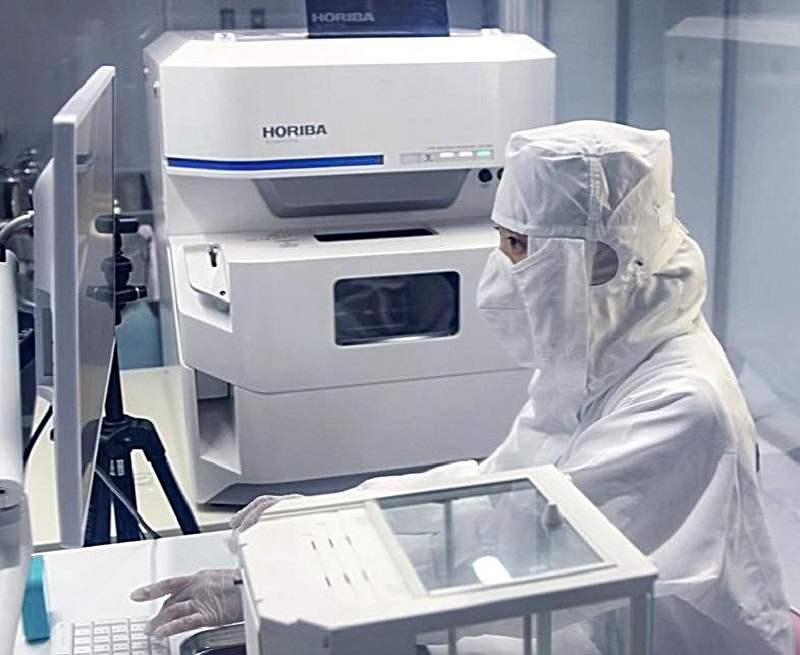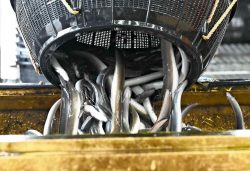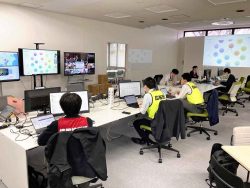
A researcher analyzes samples from the Ryugu asteroid.
17:57 JST, June 10, 2022
Samples from the Ryugu asteroid that were collected by the Hayabusa2 space probe contain traces of water, according to a paper by researchers from Hokkaido University, the Japan Aerospace Exploration Agency, and other institutions that was published in the Science academic journal.
The researchers claim the discovery could shine a light on the origin of the solar system and the mystery of where the water in Earth’s oceans came from.
According to the paper, water and substances indicating the existence of water added up to 7% of the sample’s weight. The minerals are believed to have been created about 5 million years after the birth of the solar system 4.6 billion years ago.
Discovered in 1999, Ryugu orbits the sun between the Earth and Mars. It was selected for the Hayabusa2 mission because it was believed to be a C-type asteroid. Such asteroids contain water and organic compounds, which are the building blocks of life.
Ryugu has a roughly spherical shape and is approximately 900 meters in diameter. It is believed to have been formed from smaller space rocks following the breakup of a larger body.
According to the team, the larger body might have had a temperature of 40 C and contained water in liquid form 5 million years after the birth of the solar system. The researchers think the samples might not have been exposed to violent collisions or temperatures exceeding 100 C since that time.
Some scientists believe water was brought to Earth when it was being formed from meteorites and asteroids such as Ryugu.
However, properties of the atoms in the water traces from the Ryugu samples are slightly different from those of water on Earth, according to the team.
“The samples are like fossils of the solar system,” said University of Tokyo Prof. Shogo Tachibana, a member of the team analyzing the samples. “They will significantly advance our research into the origin of the solar system.”
Hayabusa2 collected sand and stone from Ryugu in 2019, when it completed two landings on the asteroid in February and July. The unmanned space probe returned to Earth in December 2020 with 5.4 grams of samples.
“The samples may very well have preserved the early state of the solar system,” said Hiroyuki Kurokawa, a specially appointed associate professor at the Tokyo Institute of Technology. “More traces of water were found than expected. I’m looking forward to seeing the results of further analysis.”
The samples have been distributed to research teams in Japan and overseas.
A team including researchers from Okayama University has announced that 23 types of amino acids were detected in the samples.
The team found nearly 10 types of amino acids, which make up the proteins of living organisms. This is considered to be one of the strongest pieces of evidence to support the theory that the materials for life on Earth came from outer space.
"Science & Nature" POPULAR ARTICLE
-

Genome Study Reveals Milestone in History of Cat Domestication
-

Big Leap in Quest to Get to Bottom of Climate Ice Mystery
-

Security Camera Footage Vulnerable to Outside Access; Investigation Finds 3,000 Pieces Exposed Online
-

Paws on Parade: Nairobi’s Dogs Dazzle at ‘Pawchella’
-

Japanese Eels Escape New Regulation in Vote at CITES Meeting, Avoiding Higher Prices for Dealers and Diners
JN ACCESS RANKING
-

Keidanren Chairman Yoshinobu Tsutsui Visits Kashiwazaki-Kariwa Nuclear Power Plant; Inspects New Emergency Safety System
-

Imports of Rare Earths from China Facing Delays, May Be Caused by Deterioration of Japan-China Relations
-

University of Tokyo Professor Discusses Japanese Economic Security in Interview Ahead of Forum
-

Japan Pulls out of Vietnam Nuclear Project, Complicating Hanoi’s Power Plans
-

Govt Aims to Expand NISA Program Lineup, Abolish Age Restriction
























